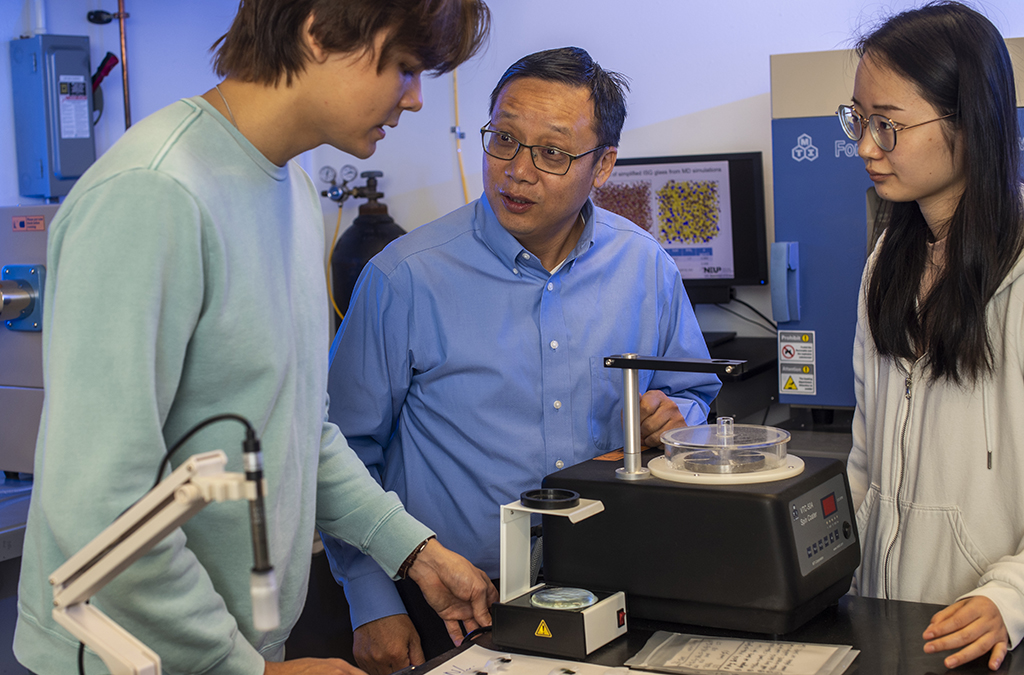
Next-generation nuclear power plants have the potential to address future energy needs and the global climate crisis. Designed to be more efficient and safer than traditional nuclear reactors, these new reactors will operate at higher temperatures and use alternate cooling methods. Proposed designs using molten salt instead of water to cool the reactor show some of the most promise.
As the result of funding from the Department of Energy’s Advanced Research Projects Agency-Energy (ARPA-E), UNT will team up with Citrine, Inc., a materials informatics and AI company, and Pacific Northwest National Laboratory (PNNL) to develop a safer and more efficient method of containing and recycling molten salt nuclear waste from nuclear reactors and other sources — a critical link in making these plants feasible.
“If you heat salt to a high enough temperature, it will become a liquid, which can flow and carry the heat generated in the nuclear reactor, as well as in concentrated solar power plants. The heat can then be used to generate electricity and for other applications,” says Jincheng Du, UNT professor of materials science and engineering. “But the molten salt from nuclear reactors needs to be recycled or reprocessed after use in order for this to become a viable process.”
UNT will receive $1.05 million of a new $3.1 million grant from ARPA-E to develop a phosphate glass-based waste form for use in molten salt reactors. ARPA-E, which operates under the U.S. Department of Energy, advances high-potential, high-impact energy technologies that are too early for private-sector investment. The grant will be shared with Citrine, Inc. and PNNL.
There are two potential applications of the new waste form processing the team is targeting — molten salt nuclear reactors and reprocessing of spent nuclear fuels.
“Spent fuel rods from nuclear reactors can be dissolved in molten salt. You can take the useful metal out, and then what remains behind can be stored safely,” Du says. “This completes the fuel cycle, making this a more realistic plan for the future of next-generation nuclear reactors.”
The nuclear waste will be reprocessed and the salts and metals reused, so that ultimately the amount of waste that will have to be stored will be much less than in current power plants. The solid waste will be stable and safe to store.
“Our design goal is a waste form that can take as much waste as possible to reduce the volume and mass of the final waste,” Du says. “We aim to have significantly higher waste loading than the current technologies and at the same time meet chemical, mechanical and other technical requirements.”
Du and his collaborators have been working on nuclear waste development with a previous grant from the Department of Energy Frontier Research Center (EFRC) named WastePD. The new AARP-E grant will be used for creating prototypes and samples to help prove the concepts they have modeled. Due to the nature of studying nuclear waste, not all of the project can be conducted at UNT. Researchers at PNNL have the capabilities to handle radioactive materials and other expertise needed for the project.
“Our goal is to use physics modeling and artificial intelligence guided experimentation to design a waste that is many times more efficient than existing waste forms,” Du says. “I think it’s a unique combination of strength of the three teams. We have the expertise in physics-based modeling of glass and ceramic nuclear waste materials, as well as their interactions with the environment. Citrine has the expertise of artificial intelligence and materials data management. PNNL has the capabilities of experimentation and design and can process the waste in their facilities.”
Du’s laboratory in UNT’s College of Engineering uses advanced computational methods and computer simulations to understand structures and properties of advanced glass and ceramics and applies this research to a variety of applications ranging from energy storage, biomedicine, microelectronics and nuclear waste disposal. Earlier, he also developed safer, more permanent containment for nuclear waste. Combined, these technologies have to potential for long-term environmental impacts.
“The research is very important for the future of clean energy. In order to achieve carbon neutral status, we need all kinds of energy sources to replace fossil fuels,” Du says. “Nuclear is a very important part of the game. If we can design safer, more efficient next-generation nuclear reactors, that will help us to achieve the carbon neutral goal, help us fight global warming and provide more diversified clean energy sources.”
